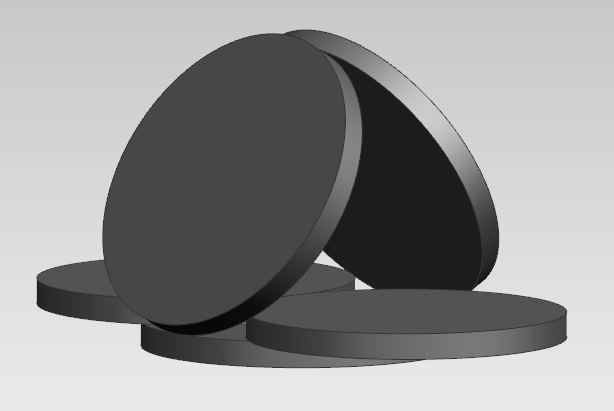Is it possible to position five 5-cent coins so that each coin touches the other four coins?
3 Answers
The answer is: it's complicated!
Obviously I didn't come up with this, but the method you'll find online is an arrangement like this:

I modeled these coins as perfect cylinders with a thickness of exactly 8% of their diameter, and all are identical. This is important because should the coins be only a tiny amount thicker, they could not touch using this (or probably any other) technique. Conversely there seems to be no limit to how thin the coins could be, as the "roof" can be adjusted until all are touching.
The problem specified 5 cent coins... and there are a bunch to choose from. The Euro coin is between 7% and 8% thickness/diameter so it should work fine. The American nickel is a hefty 9.2%, and thus will not work. The glorious Canadian Mint claims a thickness at 8.3% of their nickel's diameter, which is sadly just over the critical thickness.
Those numbers I got from Wikipedia, but I'm an Engineer by trade and I don't trust a website where any coin conspiracy theorist can edit the data. I have a 2012 American nickel and I found it to be of questionable manufacture. The thickness was not consistent, probably owing to the fact that the image of Jefferson favors the left half of the coin. Even this inconsistency probably isn't enough to reasonably claim 5 American coins could touch each other, however.
Canadian coins are nearly thin enough, but their manufacture seems better and even the edges are crisp unlike the American coins. The 1973 Canadian nickel I have was actually a little thinner than the "book value", it was right at the acceptable 8% mark. I don't have more, but I don't think its a stretch to say there could be more like it.
So sum it up: Americans are fat, Europeans are thin, and Canadians... well you could probably find 5 decent ones without looking too hard.
-
1$\begingroup$ excellent! Nicely worked out, how important the relation between diameter and thickness. $\endgroup$– ThomasLCommented Jul 9, 2019 at 19:48
It's an old puzzle...The solution can be found here:
Explanation:
Place one coin on the ground, then put 2 more on it, so that they are meeting in the middle. The other 2 coins must then be placed in the nascent slots, like a rooftop
-
$\begingroup$ Yeah... I remember it from somewhere, but you have a different answer than me. I answered it two minutes before you. +1 :) $\endgroup$– DuckCommented Jun 29, 2019 at 15:44
-
$\begingroup$ very good answers, but I think there is still a missing part. As mentioned in the article it depends on the diameter and size of the coins. I think it can be done with 5 Cent Euro coins but not with 5 Cent US coins. The problem is the touching in the nascent slots. Im happy to get further comments for that. $\endgroup$– ThomasLCommented Jun 29, 2019 at 19:05
-
$\begingroup$ @ThomasL Edited my answer and made sure it works. $\endgroup$– DuckCommented Jun 29, 2019 at 19:28
-
$\begingroup$ The nickel on the ground is harder for the three on top to touch, and it seems like it is impossible to touch from a mathematical standpoint, but if you do it on a not hard surface like carpet, it should work. $\endgroup$– DuckCommented Jun 29, 2019 at 19:34
I think I have it:
Stack two of the coins and with the rest 3 make a pyramid and place it on the two others and make sure that the pyramid coins touch both of the 2 stacked coins.
Here is a photo of it The photo is not completely accurate, as it uses pennies and quarters and the pyramid of coins doesn't touch the first coin on the ground. Edit: just tried with real nickels and tape, works, but is a little hard to tape :)
